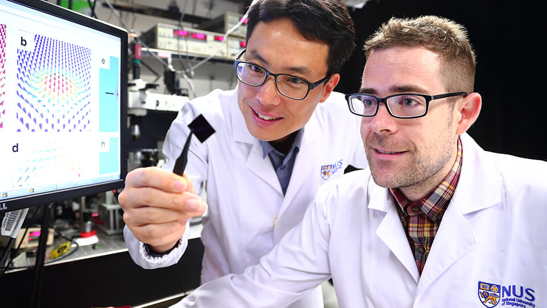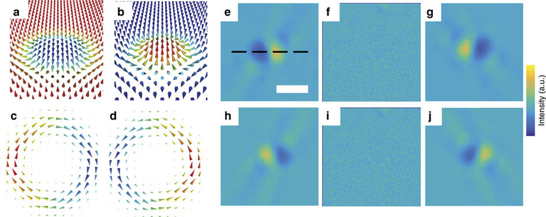R&D: National University of Singapore Researchers Invent Ultra-Thin Multi-Layer Film for Next-Gen Storage and Processing
Storage devices that use less power and work faster than existing memory technologies
This is a Press Release edited by StorageNewsletter.com on April 13, 2017 at 2:59 pmA team of scientists led by Yang Hyunsoo, associate professor, Department of Electrical and Computer Engineering at the National University of Singapore’s (NUS) Faculty of Engineering has invented a novel ultra-thin multilayer film which could harness the properties of tiny magnetic whirls, known as skyrmions, as information carriers for storing and processing data on magnetic media.
Associate professor Yang Hyunsoo (left) and Dr Shawn Pollard (right),
who are from Department of Electrical and Computer Engineering
at NUS Faculty of Engineering, are key members of research team
that invented novel ultra-thin multilayer film which could
harness properties of skyrmions as information carriers for storing
and processing data on magnetic media.
(Photo credit: Siew Shawn Yohanes)
The nano-sized thin film, which was developed in collaboration with researchers from Brookhaven National Laboratory, Stony Brook University, and Louisiana State University, is a critical step towards the design of data storage devices that use less power and work faster than existing memory technologies. The invention was reported in prestigious scientific journal Nature Communications on 10 March 2017 (see below)
Tiny magnetic whirls with huge potential as information carriers
The digital transformation has resulted in ever-increasing demands for better processing and storing of large amounts of data, as well as improvements in hard drive technology. Since their discovery in magnetic materials in 2009, skyrmions, which are tiny swirling magnetic textures only a few nanometers in size, have been extensively studied as possible information carriers in next-generation data storage and logic devices.
Skyrmions have been shown to exist in layered systems, with a heavy metal placed beneath a ferromagnetic material. Due to the interaction between the different materials, an interfacial symmetry breaking interaction, known as the Dzyaloshinskii-Moriya Interaction (DMI), is formed, and this helps to stabilise a skyrmion. However, without an out-of-plane magnetic field present, the stability of the skyrmion is compromised. In addition, due to its tiny size, it is difficult to image the nano-sized materials.
To address these limitations, the researchers worked towards creating stable magnetic skyrmions at room temperature without the need for a biasing magnetic field.
Unique material for data storage
The NUS team, which also comprises Dr Shawn Pollard and Ms Yu Jiawei, NUS Department of Electrical and Computer Engineering, found that a large DMI could be maintained in multilayer films composed of cobalt and palladium, and this is large enough to stabilise skyrmion spin textures.
In order to image the magnetic structure of these films, the NUS researchers, in collaboration with Brookhaven National Laboratory in the United States, employed Lorentz transmission electron microscopy (L-TEM). L-TEM has the ability to image magnetic structures below 10 nanometers, but it has not been used to observe skyrmions in multilayer geometries previously as it was predicted to exhibit zero signal. However, when conducting the experiments, the researchers found that by tilting the films with respect to the electron beam, they found that they could obtain clear contrast consistent with that expected for skyrmions, with sizes below 100 nanometers.
Dr Pollard explained: “It has long been assumed that there is no DMI in a symmetric structure like the one present in our work, hence, there will be no skyrmion. It is really unexpected for us to find both large DMI and skyrmions in the multilayer film we engineered. What’s more, these nanoscale skyrmions persisted even after the removal of an external biasing magnetic field, which are the first of their kind.”
Yang, assoc prof., added: “This experiment not only demonstrates the usefulness of L-TEM in studying these systems, but also opens up a completely new material in which skyrmions can be created. Without the need for a biasing field, the design and implementation of skyrmion based devices are significantly simplified. The small size of the skyrmions, combined with the incredible stability generated here, could be potentially useful for the design of next-generation spintronic devices that are energy efficient and can outperform current memory technologies.”
Next step
Assoc Prof Yang and his team are currently looking at how nanoscale skyrmions interact with each other and with electrical currents, to further the development of skyrmion based electronics.
Article: Observation of stable Néel skyrmions in cobalt/palladium multilayers with Lorentz transmission electron microscopy
Nature Communications has published an article written by Shawn D. Pollard, Department of Electrical and Computer Engineering, National University of Singapore, Singapore 117576, Singapore, Joseph A. Garlow, Material Science and Engineering Department, Stony Brook University, Stony Brook, New York 11794, USA, and Condensed Matter Physics and Material Science Department, Brookhaven National Laboratory, Upton, New York 11973, USA, Jiawei Yu, Department of Electrical and Computer Engineering, National University of Singapore, Singapore 117576, Singapore, Zhen Wang, Condensed Matter Physics and Material Science Department, Brookhaven National Laboratory, Upton, New York 11973, USA, and Department of Physics and Astronomy, Louisiana State University, Baton Rouge, Louisiana 70803, USA, Yimei Zhu, Material Science and Engineering Department, Stony Brook University, Stony Brook, New York 11794, USA, and Condensed Matter Physics and Material Science Department, Brookhaven National Laboratory, Upton, New York 11973, USA, and Hyunsoo Yang, Department of Electrical and Computer Engineering, National University of Singapore, Singapore 117576, Singapore.
Simulated magnetic structure and L-TEM images of Néel skyrmions.
(a,b) Spin structure of a skyrmion with positive DMI and a polarity of −1 and +1,
respectively. The colour corresponds to the normalized out-of-plane component
of the magnetization. (c,d) The corresponding curl of the magnetization from (a,b).
The colour represents the normalized y-component of the curl, which,
when tilted about the x axis, leads to a non-zero z-component,
and results in the formation of Néel skyrmion contrast. (e–g) Simulated Lorentz
images at −30°, 0° and 30° tilt about the x axis (indicated by the dashed line)
for nominally 100 nm, skyrmion of −1 polarity taken at −1 mm defocus. (h–j)
Same, but for the spin structure of +1 polarity skyrmion. Scale bar, 200 nm.
Abstract: “Néel skyrmions are of high interest due to their potential applications in a variety of spintronic devices, currently accessible in ultrathin heavy metal/ferromagnetic bilayers and multilayers with a strong Dzyaloshinskii–Moriya interaction. Here we report on the direct imaging of chiral spin structures including skyrmions in an exchange-coupled cobalt/palladium multilayer at room temperature with Lorentz transmission electron microscopy, a high-resolution technique previously suggested to exhibit no Néel skyrmion contrast. Phase retrieval methods allow us to map the internal spin structure of the skyrmion core, identifying a 25 nm central region of uniform magnetization followed by a larger region characterized by rotation from in- to out-of-plane. The formation and resolution of the internal spin structure of room temperature skyrmions without a stabilizing out-of-plane field in thick magnetic multilayers opens up a new set of tools and materials to study the physics and device applications associated with chiral ordering and skyrmions.“














 Subscribe to our free daily newsletter
Subscribe to our free daily newsletter
